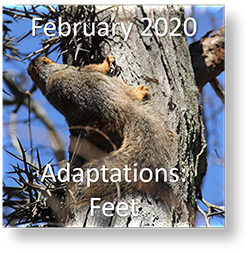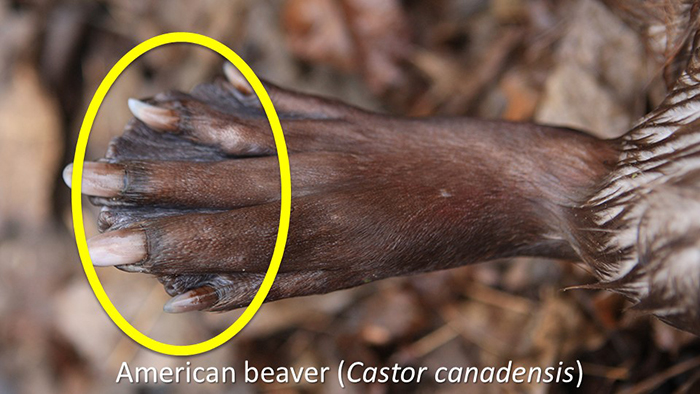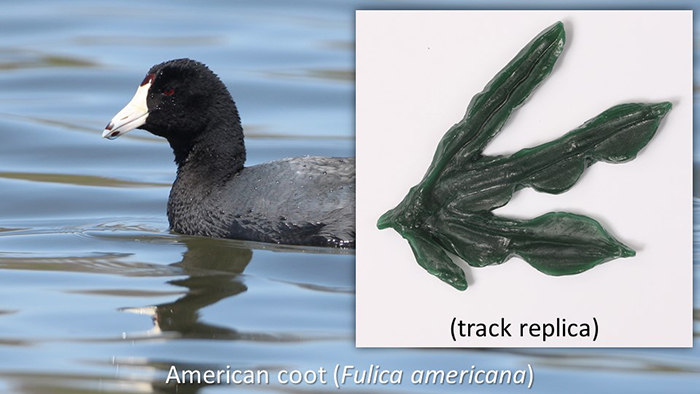
An adaptation is a feature that helps a living thing to survive. There are many types of adaptations.
The shape and structure of feet are important adaptations for many animal species. Listed below are just some of the feet adaptations of animals in Illinois. Only a few examples are listed for each topic. There are many more animals that use these types of adaptations.
Webbed Feet: Most mammals and birds that spend a lot of time swimming in or propelling themselves along the surface of water have webbed feet. The webbing is a piece of flat skin between the surface of the toes. It pushes against the water column making movement of the animal easier. Some birds, such as ducks and geese, have three toes connected. Double-crested cormorants (Phalacrocorax auritus) have four toes connected by the web.

The American beaver (Castor canadensis) has webbing on its hindfeet, while the North American river otter (Lontra canadensis) has webbing on all its feet. The American bullfrog (Lithobates catesbeianus) is an example of an aquatic amphibian with webbed feet. Turtle species that live in water most of the time generally have some webbing on their feet for swimming. Other animals may also have webbed feet. The eastern mole’s (Scalopus aquaticus) front feet face sideways, and its toes are webbed. It uses the front feet to help it move dirt as it digs an underground burrow.

Lobed Feet: The American coot (Fulica americana) lives in marshes and other wetlands and spends time both swimming in water and walking on land. Instead of webbed feet, it has lobes on the feet that can be used to help it move in water but that fold back when the coot picks up its foot while walking on land. This feature is especially helpful when the coot walks in places with tall, dense vegetation, like grasses or cattails. These feet also aid the coot in running across water as it prepares to fly when leaving a water body.
Clinging/Perching: Animals that use their feet for clinging have strong toes, often with sharp claws. Bats use their feet to hold on to the roof or the side of their roost while they rest upside-down. The back feet of the Virginia opossum (Didelphis virginiana) have an opposable toe on the side of the foot next to the body. This toe works much like your thumb. It allows the opossum to grasp all the way around small branches. Perching birds usually have three toes that face forward and one that faces backwards. This arrangement allows them to encircle branches completely with each foot. An osprey (Pandion haliaetus) has talons on its feet for grabbing and tearing its fish prey, but it also has scales on the bottom of its feet to help it cling to these slippery animals as it flies away with its catch.
Digging: A fox has claws for digging and footpads that can be spread out to help remove dirt from the hole being dug. An American badger, Taxidea taxus, has front feet shaped like scoops that it uses to dig quickly in the ground. The eastern mole’s front feet face sideways. They are broad and webbed. They can be used to push dirt as the mole digs an underground tunnel. The eastern spadefoot (Scaphiopus holbrookii) has hard structures, like spades, on its back feet that are used for digging. It digs rear-first using its hindfeet and spends most of its time under the ground. Female turtles have strong claws that help them dig a hole in which they will lay their eggs.
Grooming: A pectinate claw is present on each foot of some birds to help them groom their feathers. Barn owls (Tyto alba), herons and the common nighthawk (Chordeiles minor) are examples of birds with this adaptation that works something like a comb. The American beaver has a split claw on the second toe of each back foot. It uses this claw to groom its fur.
Exchanging Heat: Countercurrent heat exchange is an adaptation to keep the feet warm. Have you ever wondered how ducks and geese are able to stand on ice or swim in very cold water without their feet getting cold? Here’s one of the ways that they stay warm. Blood entering the foot is warm. It releases some of the warmth to the feet. The blood that leaves the feet is cooler than the blood that entered the feet. The vessels carrying blood to the heart from the feet develop next to the vessels that are taking warmer blood from the heart to the feet. The cooler blood absorbs some warmth from the warmer blood, helping to maintain a constant temperature in the animal.
Hooves: White-tailed deer (Odocoileus virginianus) are among the animals that walk on their toenails. They have a hard surface, a hoof, to cover and protect the part of the foot that they walk on. The hoof is made of keratin. (You have keratin, too. It makes up your hair and fingernails.) The hooves (plural form of hoof) grow continually to replace the old surface that gets worn away.
Walking on the Toes: Foxes and coyotes (Canis latrans) are examples of digitigrade species: they walk on their toes. Their feet have soft, tough pads on the bottom. The pads help to reduce the force on the animal’s bones when the foot hits the ground.
Retractable Claws: The bobcat (Lynx rufus) can pull its long, sharp claws into its paws. It leaves them retracted most of the time. This practice helps to keep the claws in good shape for when the bobcat needs to use them.
 Talons:
Talons: A talon is a long, sharp, hooked claw at the end of the toe in birds of prey (hawks, falcons, owls) and some other predatory animals. It is used in capturing, transporting and eating prey items.
Climbing: Woodpeckers have two toes that point forward and two toes that point backward. Along with their sharp claws, this foot adaptation allows the birds to easily move up and down along the trunk of a tree or other object.
Claws: There are a variety of claw types, and some of them have been discussed already in this list. The wild turkey (Meleagris gallopavo) is an example of a bird with strong claws on the toes. It uses them to scratch in dirt and leaf litter as it looks for insects to eat. Male turtles may use their long, front claws in courtship displays and to hold onto the female’s shell during mating.
Long Toes: Shorebirds spend a lot of time walking, wading or running. Their long, thin toes provide them with stability on wet sand or mud.

